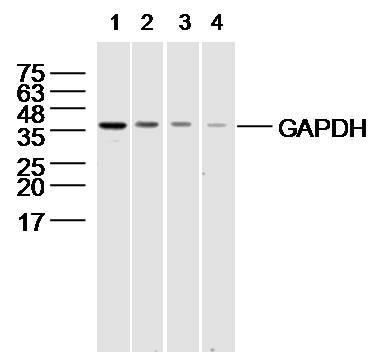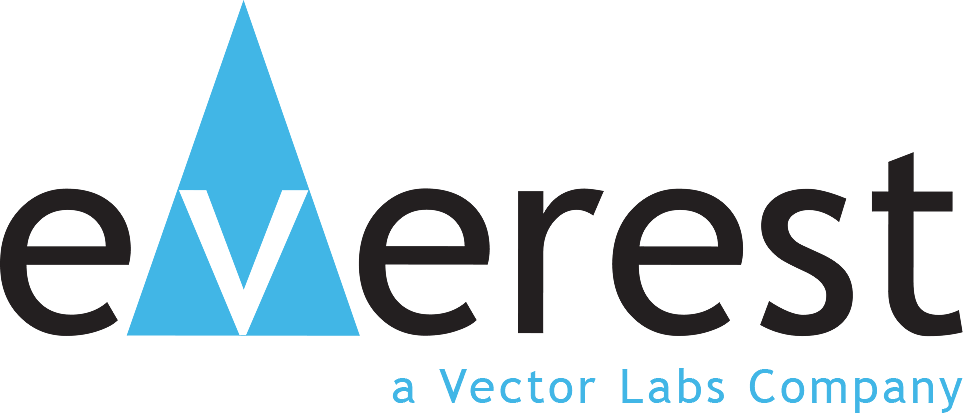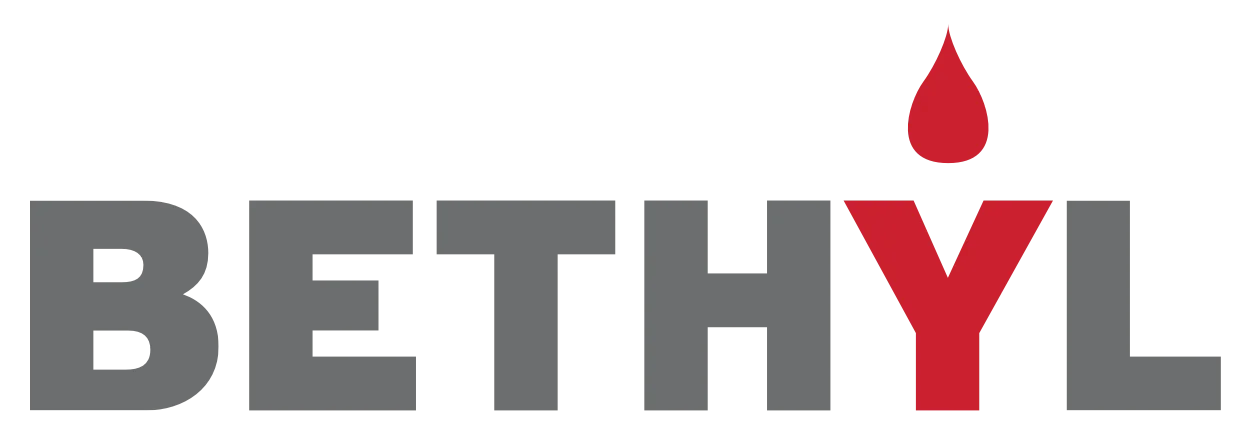
Figure 1. Western blot analysis of GAPDH using anti-GAPDH antibody (A00227-1). Electrophoresis was performed on a 5-20% SDS-PAGE gel at 70V (Stacking gel) / 90V (Resolving gel) for 2-3 hours. The sample well of each lane was loaded with 30 ug of sample under reducing conditions. Lane 1: human Hela whole cell lysates, Lane 2: human CACO-2 whole cell lysates, Lane 3: human CCRF-CEM whole cell lysates, Lane 4: rat brain tissue lysates, Lane 5: rat liver tissue lysates, Lane 6: mouse brain tissue lysates, Lane 7: mouse liver tissue lysates. After electrophoresis, proteins were transferred to a nitrocellulose membrane at 150 mA for 50-90 minutes. Blocked the membrane with 5% non-fat milk/TBS for 1.5 hour at RT. The membrane was incubated with rabbit anti-GAPDH antigen affinity purified polyclonal antibody (Catalog # A00227-1) at 0.5 microg/mL overnight at 4°C, then washed with TBS-0.1%Tween 3 times with 5 minutes each and probed with a goat anti-rabbit IgG-HRP secondary antibody at a dilution of 1:5000 for 1.5 hour at RT. The signal is developed using an Enhanced Chemiluminescent detection (ECL) kit (Catalog # EK1002) with Tanon 5200 system. A specific band was detected for GAPDH at approximately 36 kDa. The expected band size for GAPDH is at 36 kDa.
Anti-GAPDH Antibody Picoband(r)
A00227-1
ApplicationsFlow Cytometry, ImmunoFluorescence, Western Blot, ImmunoCytoChemistry, ImmunoHistoChemistry
Product group Antibodies
TargetGAPDH
Overview
- SupplierBoster Bio
- Product NameAnti-GAPDH Picoband Antibody
- Delivery Days Customer9
- ApplicationsFlow Cytometry, ImmunoFluorescence, Western Blot, ImmunoCytoChemistry, ImmunoHistoChemistry
- Applications SupplierIHP, WB, IHC
- CertificationResearch Use Only
- ClonalityPolyclonal
- Concentration500 ug/ml
- Gene ID2597
- Target nameGAPDH
- Target descriptionglyceraldehyde-3-phosphate dehydrogenase
- Target synonymsaging-associated gene 9 protein; epididymis secretory sperm binding protein Li 162eP; G3PD; GAPD; glyceraldehyde-3-phosphate dehydrogenase; HEL-S-162eP; OCAS, p38 component; Oct1 coactivator in S phase, 38 Kd component; peptidyl-cysteine S-nitrosylase GAPDH
- HostRabbit
- IsotypeIgG
- Protein IDP04406
- Protein NameGlyceraldehyde-3-phosphate dehydrogenase
- Scientific DescriptionBoster Bio Anti-GAPDH Antibody Picoband® catalog # A00227-1. Tested in Flow Cytometry, IF, IHC, ICC, WB applications. This antibody reacts with Human, Mouse, Rat, Monkey, Chicken, Zebrafish. The brand Picoband indicates this is a premium antibody that guarantees superior quality, high affinity, and strong signals with minimal background in Western blot applications. Only our best-performing antibodies are designated as Picoband, ensuring unmatched performance.
- Reactivity SupplierHuman, Mouse, Rat
- Storage Instruction-20°C,2°C to 8°C
- UNSPSC12352203
References
- The role of AdipoQ on proliferation, apoptosis, and hormone Secretion in chicken primary adenohypophysis cells.Read more
- The Cytotoxic Effects of Human Mesenchymal Stem Cells Induced by Uranium.Read more
- Epimedium-Curculigo herb pair enhances bone repair with infected bone defects and regulates osteoblasts through LncRNA MALAT1/miR-34a-5p/SMAD2 axis.Read more
- Mechanism underlying the role of integrin alpha3beta1 in adhesive dysfunction between thyroid cells induced by diesel engine exhaust particles.Read more
- Epigallocatechin-3-gallate Inhibits LPS/AbetaO-induced Neuroinflammation in BV2 Cells through Regulating the ROS/TXNIP/NLRP3 Pathway.Read more
- Metabolomics combined with network pharmacology reveals a role for astragaloside IV in inhibiting enterovirus 71 replication via PI3K-AKT signaling.Read more
- Role of transforming growth factor-beta1 pathway in angiogenesis induced by chronic stress in colorectal cancer.Read more
- Loss of SIL1 Affects Actin Dynamics and Leads to Abnormal Neural Migration.Read more
- Expression and potential molecular mechanism of TOP2A in metastasis of non-small cell lung cancer.Read more
- SHARPIN contributes to sevoflurane-induced neonatal neurotoxicity through up-regulating HMGB1 to repress M2 like-macrophage polarization.Read more













